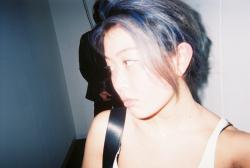Artist Nishant Malhotra Brings the Concept of ‘Ego Death’ into the 21st Century
Ego Death or ‘ego dead,’ which is artist Nishant Malhotra‘s username on Instagram, is a concept with a special resonance in the Bay Area. While other Bay Area natives associate this concept with the ’70s counterculture movement or techies trying to flaunt their newly-found SF enlightenment, Nishant is inspired by the ancient origins of ego death. His paintings are colorful, chaotic musings on both the ‘good’ and the ‘bad’ that one’s ego can cause, but the next step in this artist’s practice is getting younger generations to tune into the concept.
Over quarantine, Nishant released a series of t-shirts to give his friends a way to wear these ideas on their chests. Actually, you might already own a t-shirt from this artist– he’s also designed merchandise and visuals for popular rappers like GT, Shaggy, and Wyclef Jean. As he prepares to launch new, elevated “art wearables” next week on his website, we sit down with the artist to learn more.
So Nish, how long have you been painting?
I’ve been painting and drawing my whole life. As long as I can remember I preferred drawing over most other “regular kid” hobbies. I probably started really painting consciously around the age of 10 or 11. I can’t recall what initially drew me to painting specifically, but I definitely remember moments when I was younger and I’d be painting with my headphones in and it was just the best feeling.
You also work as a graphic designer, is there any relationship between your design practice and painting practice?
Painting is much more therapeutic than design, because of how little calculation I need to do when painting. There’s definitely a degree of calculated thought when painting; however, it comes more so from a space of expression, not so much appeasement for a specific person or market group. There are some pieces that overlap, but in terms of practice, I feel like the methods are quite different. As far as graphic design goes, I’m usually designing for a client or someone, but when I’m painting it’s for myself.
Is painting like a form of meditation for you?
Painting is definitely a form of meditation for me, and meditation is a deep ‘core’ of what defines my purpose as a human being on this planet. Since 2014, I’ve been working towards treating every action in my daily life as a meditative practice. Painting is an easy way for me to meditate while doing something other than crossing my legs and closing my eyes. For me, meditation is one of the most interesting activities in human existence. I mostly practice Vipassana Meditation; however, I’m ever-changing and always dabbling in different methods of communicating with the ‘divine’ such as Bhakti Yoga, Gyana Yoga, Tantric Yoga, and Karma Yoga.
Your solo show in New York “EGOS DIE TOO“ presented a narrative of the transmigratory experience known as “ego death.” Is this process based on any ancient texts, existing research, or any other inspiration?
Yes, most definitely! I’ve been interested in the concept known as “Ego Death” for the past few years. Simply put, ego death is the “complete loss of subjective self-identity.” I believe that when we transcend from our self-identities we merge with something greater, a network of consciousness, the web that ties us all together. This process has been underlined in many ancient texts, varying through the beliefs in Hinduism, Buddhism, as well as some Judeo-Christian religions. Some of the ancient text that really inspired me include The Tibetan Book of the Dead and the Bhagavad Gita. In terms of more modern books, Be Here Now and The Psychedelic Experience are staples in my collection.
Your work has bright colors, but your figures are in chaotic or distorted positions, which feel a little dark. Is your work meant to leave viewers feeling a certain type of way?
The duality of having these contorted figures in a bright playful environment acts as a juxtaposition to create a sense of disassociation. It’s meant to leave viewers reflecting on their current position with their egoic constructs. My work wasn’t intended to be neither light nor dark; however, I’ve noticed that in Western culture we seem to associate “death” with “dark.” I can definitely see why my work may seem dark, especially the concept of it all, but I want to try to help reintroduce the general concept of death, so that it isn’t associated with darkness. I think that we can benefit greatly as a civilization by changing the way we treat death as well as our egoic constructs.
You often listen to music while painting. Could you share what you’ve been listening to on repeat?
Artists I love to listen to when painting are Pharoah Sanders, John & Alice Coltrane, Herbie Hancock, Sun Ra, Roy Ayers. I’ll usually throw something like that on shuffle and get to it. I love crazy 1970’s avant-garde jazz and soul. It all helps me get deeper into this meditative headspace. 2 songs that have been on repeat are “The Creator Has a Master Plan” by Pharoah Sanders and “Om” by John Coltrane.
Thanks Nish! Check out more of his work on Instagram and stay tuned for next week’s apparel release on his website.












